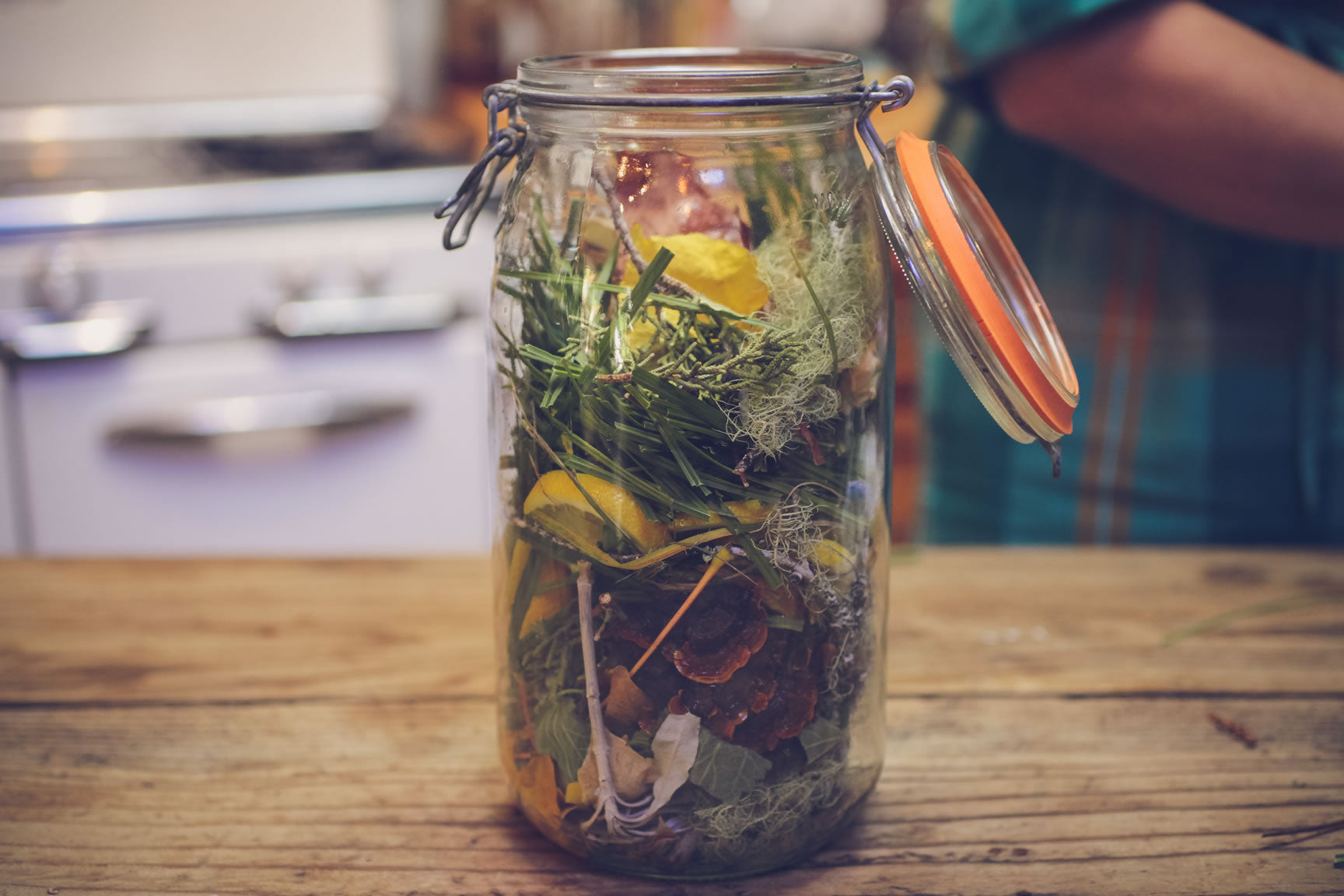- Continue Shopping
- Your Cart is Empty
Cold Infused Wild Soda: A Toast to the Natural World

What You'll Need
Equipment
Ingredients for 1 gallon
- 20% forest grass
- 10% stinging nettle
- 10% wild mint such as yerba buena
- 30% fir and pine needles
- 10% juniper leaves and berries
- 10% clean fallen leaves, such as maple, alder, or willow. If you are allergic to aspirin, do not use willow leaves.
- 10% turkey tail mushrooms and usnea lichen
- 3 lemons, sliced
- 1 cup honey
- 1/4 packet Champagne yeast (1.25 grams)
- 1 gallon fresh unchlorinated spring water
I thought I was a pretty accomplished wild fermenter, before I started following Pascal Baudar; his opus, The New Wildcrafted Cuisine: Exploring the Exotic Gastronomy of Local Terroir, has reawakened me to the possibility that has been untapped all around me, on the forest floor, in the branches of native trees and shrubs, on fallen logs, even in stones… I am both humbled and excited to look at the natural world afresh, as a place that is rich in untapped flavor and the freedom to experiment.
His recipes are not so much recipes in and of themselves, but starting places, ideas, permissions.
Take this wild soda, for instance, which is a blend of several of his recipes, tailored to what came easily to hand in my own corner of the woods.
Ingredients are given not as specified quantities, but as rough percentages of a whole. And what ingredients! Forest grass, stinging nettle, wild mint. Fallen leaves and turkey tail mushrooms and juniper berries, sprigs of Douglas Fir and usnea.
This is as good a time as any to remind people that, despite the radical exhortations of professional foragers and food writers aside, it is unwise to collect and ingest any wildcrafted ingredient that you are not intimately familiar with. Can’t tell a true turkey tail from a false? DON’T EAT THEM. Can’t tell a sedge from a grass, a tan oak leaf from a live oak leaf from a poison oak leaf? Don’t eat them. Become familiar with the plants and fungi that make up your immediate environment, and your life will be exponentially richer, regardless of whether you make this wild soda, or not. It is also worth pointing out that all, or most of these ingredients, are available in dried form at many a local health food store. Nettles, mint, and juniper are all fairly easy to find, and may prove to be a good compromise between the wild and the tame, a safe yet exciting step into the wild world of fermentation.
These sodas, like other probiotic fermented beverages, are not intended to be shelf stable; drink them within a week or two, for best flavor, and store in the refrigerator after secondary fermentation.
Get Wild!
Directions
1) Prep your ingredients
Clean the foraged ingredients, roughly chopping the leaves, grass, and needles to allow their flavor to infuse more quickly into the brew. Watch out for those stinging nettles; it’s not just a clever name.2) Fill your jar
Loosely fill a clean 1-gallon container with the grass, mint, nettles and other foraged ingredients, as well as the lemon slices.
3) Make your syrup and combine
In a bowl or glass, combine the honey and a small amount of warm water, stir to dissolve. Pour the dissolved honey into the container with the foraged mixture, and top with the rest of the cool, unchlorinated spring water.
4) Add yeast
Add the champagne yeast and allow it to float on the surface for a minute before swirling the container to distribute the yeast.Secure a lid LOOSELY on the top of the jar, or use an airlock like the Pickle Pipe for extra sanitation. If you do not use an airlock, you will need to crack open the jar a couple of times a day to release the carbon dioxide that is a byproduct of fermentation to escape.
5) Ferment and Shake daily
Stir or shake two or three times daily.
Allow the mixture to ferment until you see bubbles actively forming in the liquid portion of the brew. You may also see a whitish sediment forming at the bottom of the container; this is a byproduct of the action of the yeast and is nothing to worry about.
6) Strain and bottle for secondary fermentation
Strain the fermenting soda to remove the solids from the liquid.
Funnel the liquid into swing top bottles and close them up tight; leave them out on the counter at room temperature, and check for appropriate carbonation after 8 hours. 
Depending on the vigor of your fermentation, the pressure may be right at this time, or may require several hours more at room temperature to build up to the level that you like. Too long left at room temperature will create an excess of carbonation, and the possibility of exploding bottles; for this reason, some folks like to bottle into recycled plastic soda bottles. To test the level of carbonation in a plastic bottle without opening the top and releasing some of the gas, simply squeeze the bottle. A well carbonated beverage makes the plastic bottle firm and hard to the touch; sodas that need a little more time will have more give to the bottle.
7) Refrigerate and Enjoy!
When the soda has reached the desired level of carbonation, place the bottles in the fridge to halt or slow fermentation. Consume within 2 weeks.A toast to the natural world.

Over to You
It’s part of our mission here at Mountain Feed to help you make delicious, sustainable, homemade food more often. Stop by and say hello on Facebook, Twitter, Instagram or Pinterest. Or, as always, you can do it the old fashioned way and come by the store to speak with one of our in-house experts.
